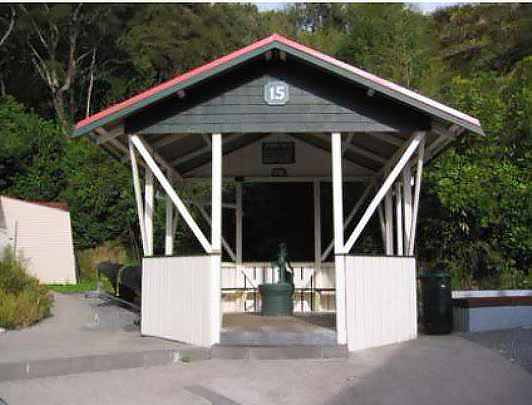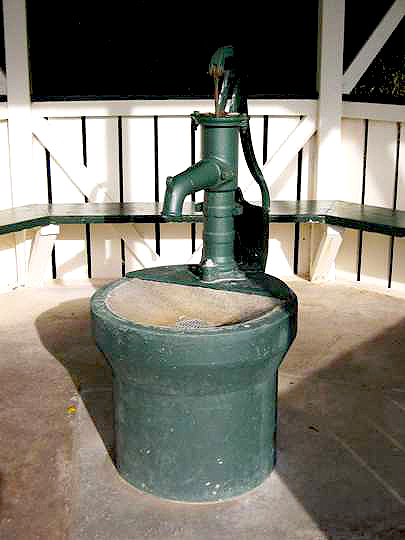During the late nineteenth and early twentieth centuries, the Hot Springs Domain at Te Aroha was the most popular geothermal resort in New Zealand. The Domain was initially established as a reserve in 1881, incorporating an area of 9.1 hectares (20 acres) on the lower slopes of Mount Te Aroha. The many hot springs in this area lay within the traditional territory of Ngati Rahiri, a hapu of Ngati Maru of Hauraki, and had long been frequented by Maori for their perceived healing qualities. By the late 1870s the site had become a popular destination for Pakeha visitors, with tourist numbers increasing after the discovery of gold on Mount Te Aroha in 1880 and the development of Te Aroha township as a mining settlement. The Domain was acquired by the government soon after the passing of the 1881 Thermal Springs District Act, with local Maori - who had played an instrumental role in initially promoting the resort - retaining the right of free access to the waters. The 1881 Act had been introduced to promote Crown ownership of New Zealand's thermal resources, partly in response to their increasing purchase and commercial exploitation by private entrepreneurs. The earliest permanent buildings in the Domain were erected soon after the reserve was brought under the Public Domains Act in 1882, and were overseen by the Te Aroha Hot Springs Board. By 1887, there were seven bath houses and a drinking fountain, with extensive grounds laid out to plans drawn up by Henry Crump, a local engineer and architect. Government money largely financed the development of the facilities, as well as the establishment of a railway from Auckland in 1886. As the centrepiece of the now-burgeoning town of Te Aroha, the spa became the first geothermal resort in the country to receive thousands of visitors on an annual basis. People came to bathe or ingest its waters for health reasons, but also to promenade, listen to music or play genteel forms of sport such as tennis, croquet and bowls. Spas had important associations in nineteenth-century European society as places where the well-to-do could relax and congregate in refined and beautiful surroundings. Although the health and leisure aspects of the reserve were heavily promoted when it was taken over by the Department of Tourism and Health Resorts in 1903, the facilities went into a slow decline after government funding and visitor attention were steadily drawn to Rotorua. The Domain nevertheless remained an extremely popular destination until after the First World War (1914-1918), and continued in a reduced capacity as a spa thereafter. Following closure of many of its facilities in the 1950s and 1960s, the Domain was transferred to the control of the local council (now Matamata-Piako District Council) in 1979, while formally remaining in Crown ownership. The No.15 spring was one of numerous sources of water in the Domain whose properties were believed to be medicinal. Water from the spring was considered particularly good for curing dyspepsia and for liver complaints, and was also held to be the most palatable in the reserve. It was bottled and sold throughout New Zealand by various companies from 1886, sometimes with lemon added as flavour. Water from the No.8 spring was also sold, although it was believed to hold different properties. The reputation built by these springs helped to create a situation whereby Te Aroha water was the most popular mineral or table water in New Zealand until the 1970s. The physical development of the No.15 spring had already begun by 1886, when it is said to have been covered in like a well. In 1898 a small concrete tank was put around the spring and a hand pump was probably also installed. The latter occurred during a period of great development in the Domain, which took place under the supervision of the District Engineer, Charles Vickerman. By 1904, surplus water from the spring was going into the main reservoir situated near the No.2 Bath House. From 1908, the Tourist Department controlled the franchise for selling water from the spring at the new Rotorua Bath House, where it retailed for a penny a cup in the foyer. This commodity was conveyed in bulk cans, before being siphoned and aerated at Rotorua. In 1910, the spring's status as an attraction was reinforced with the construction of a rustic octagonal-shaped structure around the pump. This was erected of ti-tree lattice and some oak ornamental work with a nikau thatched roof. Built at a cost of £6.16.0, it included a concrete floor with a three inch fall from the centre. Manuka trellis seating was provided and a rockery formed around its base, with ferns and shrubs planted. In 1936 this structure was considered to be inadequate for dealing with rain, and its replacement by a more substantial structure at an estimated cost of £15 was suggested. A new solid wooden structure was then built probably by the early 1940s, forming the current octagonal structure on the site. In spite of the decline of ingesting spa water as a medicinal cure, the spring retained its adherents and in 1949-1950, 72 quarts of water were exported to Australia for the use of a visitor who had benefited from its qualities. In the 1970s, however, the Health Department removed the hand pump after the water was found to contain traces of arsenic and other harmful chemicals. A pump and basin were reinstated in 1990 on the understanding that only small quantities of the water should be consumed. The building has recently been enclosed within the compound of a new open-air pool and has had its corrugated iron roof replaced.


Location
List Entry Information
Overview
Detailed List Entry
Status
Listed
List Entry Status
Historic Place Category 2
Access
Able to Visit
List Number
2697
Date Entered
12th December 2003
Date of Effect
12th December 2003
City/District Council
Matamata-Piako District
Region
Waikato Region
Extent of List Entry
Registration includes the structure, its footings and the ground beneath its footprint. It includes all fixtures and finishes. Including its hand pump and basin.
Legal description
Sec 16 Blk IX Aroha SD (Recreation Reserve NZ Gazette 1882 p.1860)
Related listings
Stay up to date with Heritage this month
